In this week’s class on tabletop miniature wargaming, you are going to learn the fundamentals of building the ground over which your miniature soldiers will fight, and upon which they will bleed. You should expect to spend no more than twenty dollars for this utilitarian terrain terrain system, which will provide countless variations capable of covering most battle situations. This system also provides an easy to transport outdoor terrain system for your tabletop RPG sessions as well.
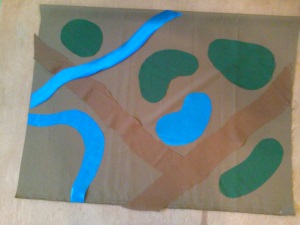
A bland first step that is vastly improved with a few easy tweaks
Before discussing how to build a basic terrain set that is cheap, attractive, utilitarian, and transportable, you need to consider the purpose of the terrain. Theoretically, no terrain is necessary. Your miniature troops can find on an empty space. Historically, this is the nature of many ancient battles. Scipio’s defeat of Hannibal at Zama and Alexander the Great’s victory over Darius at Gaugamela, for example, were fought on ground unbroken by hill, stream, or forest. Even then, though, fighting over a wooden or glass tabletop leaves too much to the imagination for wargamers. If you’re going to spend hours researching, priming, and painting your troops to make them look their best, you will at least want a ground colored mat for them to fight over.
More than that, though, the importance of terrain lies in the way it forces choices upon the players. Terrain features add a critical variable to the game that each player must account for when choosing a strategy. Options add variety and interest to the game, and for that reason, you’ll want to craft a set of terrain that allows for variety and interest in your games. Indeed, the presence or absence of defensible terrain can play a vital role in balancing opposing forces made up of unbalanced power. Without the sea to the right and high cliffs to their left, the 300 Spartans would have been easily swamped by the forces of Darius. With those two single terrain elements, a slaughter became an epic battle that remains the subject of artists to this day.
Terrain features can generally be broken down by the effect they have on the figures, and consist of three major types: those that affect movement, those that affect line-of-sight, and those that affect both. In the case of movement, terrain might block it outright (e.g. cliffs or raging rivers) or merely slow movement down (e.g. woods, streams, or broken ground). Roads are a special case in that they might even increase a unit’s movement. In the case of lone-of-sight most terrain either blocks it altogether (e.g. buildings, hills, and dense woods), but in some rare cases terrain may have a variable effect. Chest high walls might count as blocking line of sight for all figures not in contact with the wall, for example. You will want a mix of all three for your table.
With those considerations in mind we head to the fabric store. You can buy pre-painted drop cloths specifically manufactured for miniature wargames, if you are willing to spend from $30 up into the hundreds of dollars. In that case, you will only have the ground cover itself and still need to lay out additional funds for streams, hills, and rivers. Or you can spend about ten dollars on fabric and five to ten dollars on spray paint, and have everything you need.
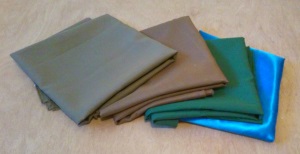
Choose your ground cloth to suit your preferences
Here’s the list of fabric you need:
- Enough light brown canvas to cover your battlefield – at least one yard and possibly two
- 1 yard of green linen or felt
- 1 yard of dark brown linen or felt
- 1 yard of rich blue satin
You also want to buy three cans of the cheapest spray paint you can find, one each in brown, green, and yellow.
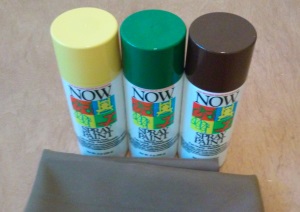
Cheaper is better – you don’t need high quality mottling
The light brown canvas will be the base for the drop cloth. You’ll note that as a monochrome fabric it lacks the shading and colors of actual ground cover, and that’s where the spray paint comes in. A heavy canvas will last a long time, withstand wrinkles, and best of all, will hold paint.
Lay out your ground cloth somewhere outside and begin dusting it with the green spray paint. You don’t want full coverage, just a nice fractal mottled look. Repeat with the dark brown. Do this again with the green spray paint, and repeat as many times as you feel necessary to give your terrain a natural three-tone look. The last step is to lightly dust the ground cover with a hint of the yellow paint. This will add a natural lightness to the drop cloth, and give it a more three-dimensional look.
The dark green fabric will serve to delineate small copses of forest. Simply cut out three to five irregular shapes, round, kidney, or linear, all large enough to force players to have to decide between going through or around them. A dusting of green and then yellow spray paint, just as was done for the drop cloth, will give them a natural look. The darker hue implies the shadowed floor of the forest. Depending on the rules and units you are using, these woods might slow troops or even block them altogether. If you want to distinguish between heavy woods that block all movement and light woods that merely slow it down, you can even use two different colors of template for forest.
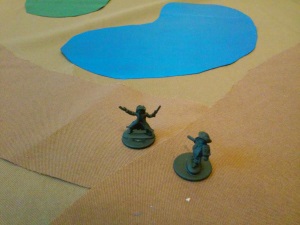
These roads may be a bit wide for these 15mm figures, but remember they need to be wide enough for a pair of horses pulling a carriage
The dark brown linen is used to make roads. Simply cut out irregular strips and spray with a bit of dark brown and dust with yellow. The width of your road will depend upon the scale of your figures, but should range from one to four inches. As you can see, my roads are cut to resemble the sort of one-lane dirt tracks common in the French Countryside and suitable for use by highwaymen out to relieve corrupt nobles of their heavy coin purse burdens. If you game modern or future battles, you should use a nice gray fabric instead of brown to represent paved concrete instead of muddy dirt tracks.
One note about road systems: you may be tempted to build long, straight roads. Don’t. As with all of your terrain, perfectly symmetrical features don’t look natural and don’t open up meaningful choices for the player. If the left side of the board looks like the right side of the board, then which side to advance on doesn’t offer a meaningful choice. Straight roads also provide broad, wide open fields of fire that bisect battlefields. Again, the obvious benefit of such things forces players into a one-size-fits-every-battle mindset that you want to avoid.
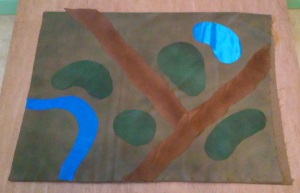
The finished project – more natural and attractive than simple drop cloths
Instead, as you can see in the photo to the right, try to cut your roads in such a way that they enter and leave at non-right angles. As you can see, this still allows for long, straight shots, but it doesn’t allow the road to dominate the battlefield in the way it would if it entered at one side, marched straight across, and left by the opposite side of the battlefield. By laying one strip under the other, you can create forks or bends, or even extend the road all the way across the battle field, if you must for historical accuracy.
The same rules apply for your waterways, which are made by cutting the satin fabric into narrow streams, wide rivers, and small ponds. I’ve opted to include a right-angle bend in my stream, but you can also overlay the fabric to get the same effect. You don’t need to paint satin fabric to give it a natural look. Satin possesses a fine sheen that mimics water all on its own. Just cut and drop, and you’ve got a liquid looking feature that can be shot over, but will at least slow down anyone looking to cross it. Before each battle, you will want to decide whether roads that cross streams are actually fords that do not slow movement, or are the only place that a stream can be crossed.
The project looks a little flat at this stage, but it’s early yet. The important thing is that we have a reasonably attractive and fully gamable surface that was inexpensive, easy to build, and easy to transport. Eventually, we will build a few bridges to allow figures to cross these satin streams. We will add trees to our woods to make it more obvious what they represent. For now, thought, we have figures and terrain, and even if it doesn’t look as great as it will, we have a complete game ready to play.
“…the 300 Spartans would have been easily swamped by the forces of Darius.”
You mean “Xerxes”, correct?
Yes, yes I did.